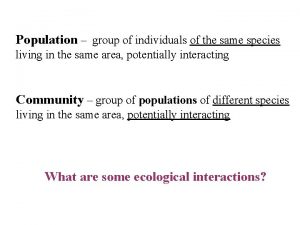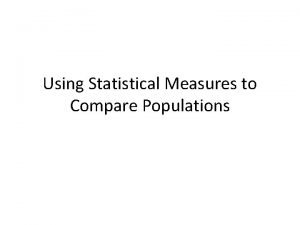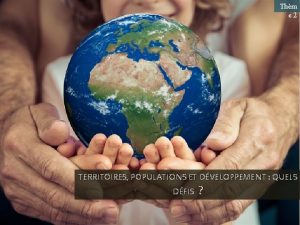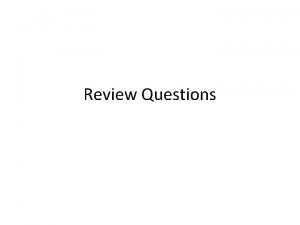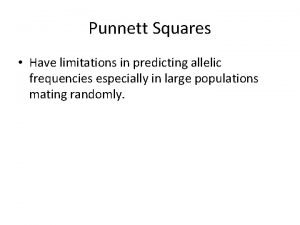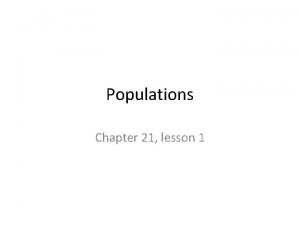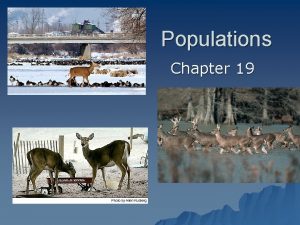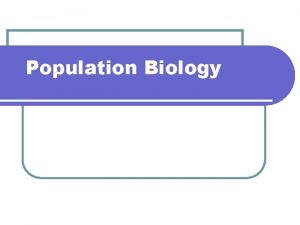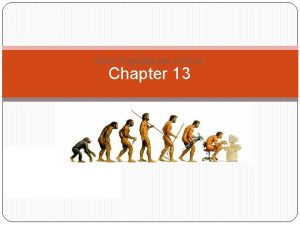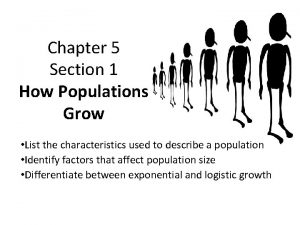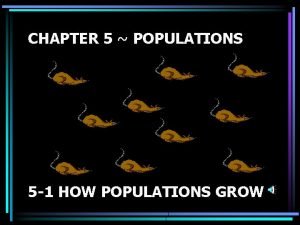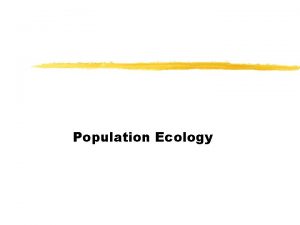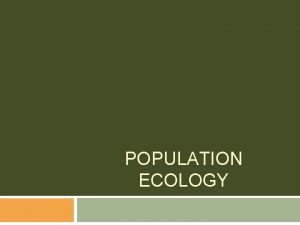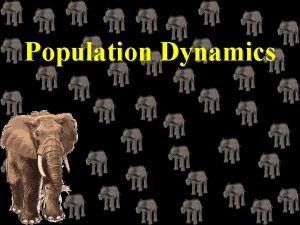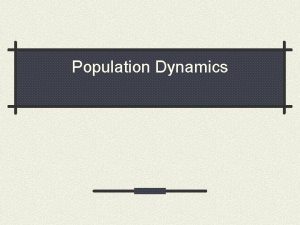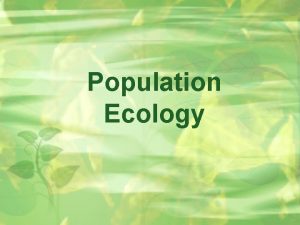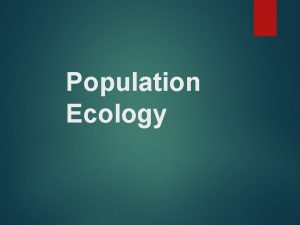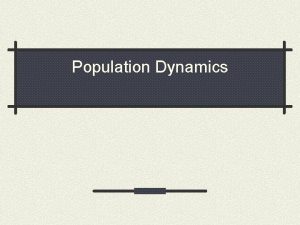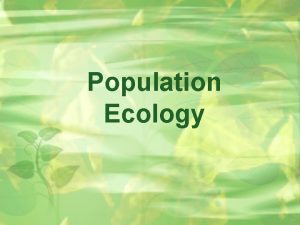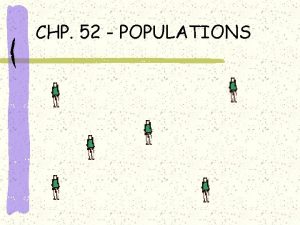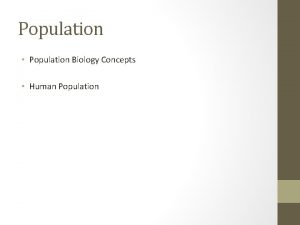Populations What is a population Group of individuals





















- Slides: 21

Populations

What is a population? Group of individuals of same species inhabiting an area

Population Characteristics 1. 2. 3. 4. 5. 6. • Natality Mortality Sex Ratio Age Distribution Population Density Spatial Distribution A population has all six of these characteristics, individuals do not

1. Natality • # of individuals added through reproduction Birth rate = __# born____ 1000 individuals Example: population size = 100, 000 # born = 1, 000 What is birth rate for this population?

2. Mortality • # of deaths per year Death rate = ___# die____ 1000 individuals What criterion must be met for population to grow?

Population Growth Example Birth rate = 25/1000 Death rate = 5/1000 Assuming an original population of 1000, what will this population’s size be in 5 years? 2009 data for U. S. : birth rate = 13. 5/1000 death rate = 8/1000

3. Sex Ratio • Relative # of males to females in a population • Usually close to 50/50 • Sex ratio does not apply to plants, earthworms and anything else that has both kinds of reproductive organs • Other anomalies: bees, more females- most are sterile. Deer more females than males, what is a good buck: doe ratio?

4. Age Distribution • # of individuals of each age in a population • cohort- all individuals of a same age in a population • For deer, we use hunting season to separate cohorts. Deer is 6 months old in December.

Age Distribution in Deer Fawn- 6 months old, typically do not reproduce 1 -1/2 2 -1/2 3 -1/2 4 -1/2 5 -1/2 If more individuals are pre or post-reproductive adults, population will not grow as fast

Age Distribution in Human Populations Fast Growth Slow Growth Zero Growth

5. Population Density • # of organisms per unit area Ex: Deer in Pennsylvania Seedling/sapling= 60 deer/sq. mile Pole timber= 10 deer/sq. mile Saw timber= 20 deer/sq. mile

How can we calculate deer population in Pennsylvania? 1. Count them (census) 2. Estimate (capture-mark-recapture) 3. Estimate using density– best for deer Example: N= population estimate m= # caught at time 1 t= # caught at time 2 p= # caught @ time 2 that were also caught @ time 1

6. Spatial Distribution • How organisms are arranged A. Random- not too common B. Uniform- unusual (each individual is a set distance apart) C. Clumped- Most common in nature

Population Growth Curves • Influenced by sex ratios and age distribution 4 Main Phases to Population Growth 1. Lag Phase- growth is slow 2. Exponential- Fast growth birth > death 3. Stable Equilibrium- birth = death 4. Death phase- death > birth

Carrying Capacity (k) • # of individuals of a species that can survive in an area 4 Factors that Impact Carrying Capacity 1. Availability of raw materials 2. Availability of energy 3. Accumulation of waste products 4. Interactions among organisms

Carrying Capacity • Remember, limiting factors: Density dependent vs. independent Ex: hare and lynx populations Cyclical, “boom and bust” What causes these fluctuations?

k-strategists • Type I Survivorship Curve • Examples: humans, bears • Larger animals, live longer, few offspring, much care for offspring, reproduce several times

r-strategists • Type III Survivorship curve • Ex: fish, insects • Smaller organisms, shorter lives, many offspring at one time, little or no care, maybe only reproduce 1 time, don’t reach k

Human Population Growth • Very long lag phase • Currently in exponential growth phase • Why?

What is Carrying Capacity for Humans? • Must consider limiting factors: 1. 2. 3. 4. Availability of raw materials Availability of energy Accumulation of waste products Interactions among organisms

Human Carrying Capacity • With all of our advancements in technology and medicine, why can’t we stabilize the global population?
 Individuals don't evolve populations do
Individuals don't evolve populations do Parasitism
Parasitism Chapter 4 section 1 population dynamics
Chapter 4 section 1 population dynamics Section 1 population dynamics
Section 1 population dynamics Population ecology section 1 population dynamics
Population ecology section 1 population dynamics Study guide chapter 4 section 1 population dynamics
Study guide chapter 4 section 1 population dynamics Using statistical measures to compare populations
Using statistical measures to compare populations Territoires populations et développement quels défis
Territoires populations et développement quels défis Stabilizing selection human birth weight
Stabilizing selection human birth weight A biologist discovers two populations of wolf spiders
A biologist discovers two populations of wolf spiders Limitations of using a punnett square
Limitations of using a punnett square Lesson 1 populations answer key
Lesson 1 populations answer key Section 19-1 review understanding populations answer key
Section 19-1 review understanding populations answer key Chapter 16 evolution of populations vocabulary review
Chapter 16 evolution of populations vocabulary review Population definition
Population definition Whats a density dependent limiting factor
Whats a density dependent limiting factor Kde inclusion of special populations
Kde inclusion of special populations Chapter 13 how populations evolve test
Chapter 13 how populations evolve test Chapter 17 evolution of populations answer key
Chapter 17 evolution of populations answer key Chapter 5 lesson 1 how populations grow answer key
Chapter 5 lesson 1 how populations grow answer key 5-1 how populations grow
5-1 how populations grow Chapter 23 the evolution of populations
Chapter 23 the evolution of populations

